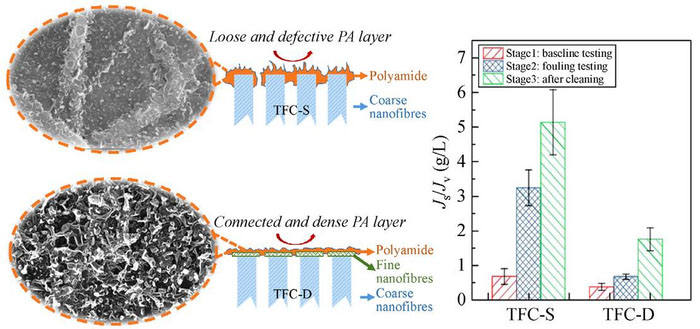| Oct 12, 2022 |
A new design of nanofiber interlayer supported forward osmosis composite membranes
(Nanowerk News) Forward osmosis (FO), an emerging membrane-based technology, possesses low energy consumption and low membrane fouling potential, but the lack of high-performance FO membrane hinders the large-scale application of FO. Generally, an ideal high-performance FO membrane should have high water permeability, low salt permeability, low structural parameter (S value), excellent antifouling performance, and stable chemical properties. Among them, nanofiber-supported FO membranes have gained popularity.
|
|
Thin-film composite (TFC) FO membranes composed of porous substrates and ultra-thin polyamide (PA) selective layers display structural design flexibility and superior permeability and selectivity. But how to overcome the ‘trade-off’ between water permeability and solute selectivity and minimize the overall S value of FO membranes? Additionally, Polyvinylidene fluoride (PVDF) is a semi-crystalline polymer with repeating units, which is widely used to prepare membrane materials for water treatment because of its strong mechanical properties and stable chemical properties.
|
|
But how to fabricate a defect-free and robust PA separation layer on the electrospinning nanofibrous substrate (PVDF) with large open surface pores via interfacial polymerization (IP)? Finally, how to effectively alleviate the internal concentration polarization (ICP) phenomenon and membrane fouling in FO?
|
|
To answer these questions, Prof. Miao Tian and Dr. Tao Mao from Northwestern Polytechnical University and their team members have worked jointly and reported the design of a dual-layer-structured PVDF nanofiber-supported TFC FO membrane. Their results revealed the behavior of foulants on the membrane surface and provide a theoretical basis for the research and development of high-water flux and anti-pollution TFC FO membranes in actual wastewater treatment.
|
|
This study is published in Frontiers of Environmental Science & Engineering ("Design of nanofiber interlayer supported forward osmosis composite membranes and its evaluation in fouling study with cleaning").
|
 |
| Graphical abstract of the work.
|
|
In this study, a tiered PVDF nanofiber substrate with an ultrathin (~1 µm) fine fiber interlayer on top (average fiber diameter 40–60 nm) was successfully fabricated by electrospinning.
|
|
A PA selective layer was synthesized using IP on an aforesaid nanofibrous substrate with various physicochemical properties. FESEM and AFM were used to study the effect of the electrospun nanofiber interlayer and drying time on the intrinsic separation FO performance.
|
|
The separation performance of the dual-layer nanofibrous FO membranes was examined using model foulants (sodium alginate and bovine serum albumin) in both the feed solution (FS) and draw solution (DS). The dual-layer nanofibrous substrate was superior to the single-layer nanofibrous substrate and showed a flux of 30.2 LMH when using 1.5 M NaCl against deionized water in the active layer facing draw solution mode.
|
|
In the fouling test, the water flux was effectively improved without sacrificing the water/solute selectivity under the condition that foulants existed in both the FS and DS. In addition, the dual-layer nanofibrous TFC FO membrane was more robust during the fouling test and cleaning.
|
|
This study demonstrates the importance of the interlayer in improving the TFC FO membrane. The interlayer enhanced the selectivity of the PA layer during long-term operation and cleaning. In short, the study provides a theoretical basis for the research and development of high-water flux and anti-pollution TFC FO membranes in actual wastewater treatment.
|

